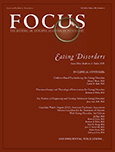The Emergence of Eating Pathology after Bariatric Surgery: A Rare Outcome with Important Clinical Implications
Abstract
Objective:
Method:
Results:
Discussion:
Introduction
Method
Results
| Authors | Location | Demographic Information | Type of Surgery | Pre-Surgery BMI (kg m−2) | Lowest Post Surgical BMI (kg m−2) | ED-Related Behaviors |
|---|---|---|---|---|---|---|
| Shamblin et al. (1984)9 | United States | * | Gastroplasty Surgery | * | * | Bulimia nervosa |
| Mitchell (1985)10 | United States | 41 y. o. Female | Gastric Stapling | * | * | Binge eating 1,000 to 4,000 calories, self-induced vomiting |
| Thompson et al. (1985)11 | United States | 37 y. o. Female | Gastroplasty Surgery | 31 | 17 | Binge eating, self-induced vomiting |
| Ringel (1987)12 | United States | 40 y. o. Female | Gastroplasty Surgery | * | * | Bulimia nervosa |
| Viens and Hranchuk (1992)13 | Ottawa, Canada | 35 y. o. Female | Gastrectomy | * | * | Binge eating, self-induced vomiting |
| Bonne et al. (1996)14 | Jerusalem, Israel | 27 y. o. Male | Vertical Banded Gastroplasty | 47 | “15% below normal standards” | Eating 400 Calories/day |
| Bonne et al. (1996)14 | Jerusalem, Israel | 19 y. o. Male | Vertical Banded Gastroplasty | 45 | 62* | Eating 300 Calories/day, vomiting |
| Atchison et al. (1998)15 | South Australia | 44 y. o. Female | Gastric Bypass | * | 19 | Laxative use, self-induced vomiting |
| Atchison et al. (1998)15 | South Australia | 53 y. o. Female | Gastric Bypass | * | 15 | Excessive exercise, laxative use, vomiting, restricted categories of food |
| Scioscia et al. (1999)16 | United States | 38 y. o. Female | Gastric Bypass | 56 | 16.2 | Avoided eating, preoccupation with weight, self-induced vomiting |
| Counts (2001)17 | United States | 39 y. o. Male w/Prader-Willi Syndrome | Gastric Bypass | 27.8 | 17.4 | Avoiding foods high in carbohydrates and/or calories |
| Guisado et al. (2002)18 | Madrid, Spain | 32 y. o. Female | Vertical Banded Gastroplasty | 43.0 | 24.2 | Self-induced vomiting, diuretic use |
| Deitel (2002)19 | Toronto | * | Gastric Bypass | * | * | Refusal to eat |
| Deitel (2002)19 | Toronto | * | Gastric Bypass | * | * | Refusal to eat |
| Cordás et al. (2004)20 | 40 y. o. | Gastric Banding | * | 26.4 | Anorexia nervosa symptoms “without low weight” | |
| Segal et al. (2004)21 | Sao Paulo, Brazil | 42 y. o. Female | Gastric Bypass | 48 | 24 | Refusal to eat, body image distortion |
| Segal et al. (2004)21 | Sao Paulo, Brazil | 41 y. o. Female | Gastric Bypass | 52 | 20 | Refusal to eat, self-induced vomiting, body image distortion |
| Segal et al. (2004)21 | Sao Paulo, Brazil | 44 y. o. Female | Gastric Bypass | 48 | 24 | Refusal to eat, self-induced vomiting |
| Segal et al. (2004)21 | Sao Paulo, Brazil | 42 y. o. Female | Gastric Bypass | 57 | 30 | Refusal to eat, body image distortion |
| Segal et al. (2004)21 | Sao Paulo, Brazil | 51 y. o. Female | Gastric Bypass | 46 | 30 | Self-induced vomiting |
| Taylor and Sharma (2006)22 | Hamilton, Canada | 25 y. o. Female | Gastric Band | * | * | Bulimia nervosa with self band adjustment |
| de Zwaan and Mühlans (2007)23 | Nürenberg, Germany | 43 y. o. female | Gastric Banding | * | 18.4 | Bulimia nervosa |
Potential Contribution of Surgical Procedures to Eating Disorders
Binge Eating Behavior
Vomiting Behavior
Predictive Value of Preoperative Eating Disorders and General Psychopathology
Treatment, Clinical Monitoring, and Future Research
Discussion
References
Information & Authors
Information
Published In
History
Authors
Metrics & Citations
Metrics
Citations
Export Citations
If you have the appropriate software installed, you can download article citation data to the citation manager of your choice. Simply select your manager software from the list below and click Download.
For more information or tips please see 'Downloading to a citation manager' in the Help menu.
View Options
View options
PDF/EPUB
View PDF/EPUBGet Access
Login options
Already a subscriber? Access your subscription through your login credentials or your institution for full access to this article.
Personal login Institutional Login Open Athens loginNot a subscriber?
PsychiatryOnline subscription options offer access to the DSM-5-TR® library, books, journals, CME, and patient resources. This all-in-one virtual library provides psychiatrists and mental health professionals with key resources for diagnosis, treatment, research, and professional development.
Need more help? PsychiatryOnline Customer Service may be reached by emailing [email protected] or by calling 800-368-5777 (in the U.S.) or 703-907-7322 (outside the U.S.).

